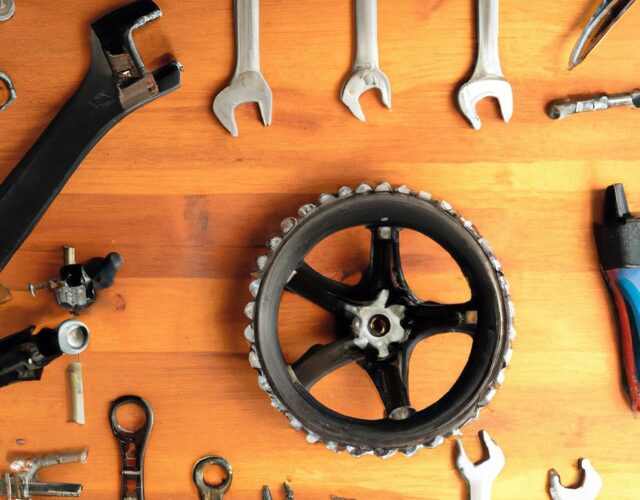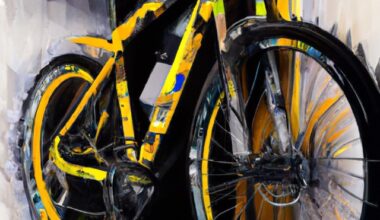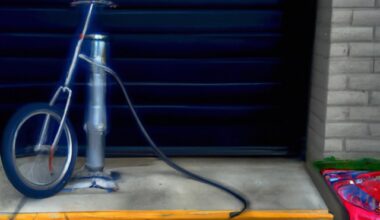Mountain biking is a thrilling and adventurous sport. It involves riding bicycles off-road, on rough terrains such as trails, mountains, and even rivers. It has grown in popularity over the years and is practiced by many people across the world. This activity requires specialized equipment and tools; this is where mountain bike kits come in.
A mountain bike kit is a collection of items that are necessary for a safe and enjoyable ride. It typically includes a helmet, jerseys, tires, paddles, brakes, and other components. Each part can be customized according to the rider’s preferences and needs. The kit should also include accessories like lights, bike pump, saddlebags, and multi-tools.
This guide will explain the basics of mountain biking and its related equipment. We will discuss what items are essential for a mountain bike kit, how to find the right components, the best accessories to add, cost and budgeting tips, maintenance routines, and safety measures.

Identifying What You Need for Your Mountain Bike Kit
Mountain biking is a great way to get some exercise and experience the wilderness. To get started, you’ll need some basic mountain bike gear and equipment. This includes items such as a helmet, jersey, tires, and other parts.
A helmet is an absolute must-have when cycling, so make sure you have one that fits correctly. It should be snug yet comfortable, and offer full coverage for your head. Jerseys are also important for comfort when riding, and you’ll want one that is lightweight and breathable.
Tires are essential for the type of terrain that you’ll be riding on. If you’re planning to ride trails and steep hills, you’ll need tires that can handle bigger obstacles. Look for knobby tires with broad treads for extra traction and durability.
Other parts you’ll need for your mountain biking kit include pedals, shifters, derailleurs, a chain, and a suspension system. Make sure everything works well together, and purchase parts that are reliable and made to last.

Finding the Appropriate Mountain Bike Kit Parts
When it comes to assembling the perfect mountain bike kit, there are a few key considerations that need to be taken into account. First and foremost, you should have a good idea of where to find the right parts for your mountain bike.
There are a few excellent online stores that specialize in mountain bikes, such as REI and JensonUSA, where you can find quality components from reputable brands. You can also check out your local bicycle shop for more specialized parts.
It is important to note that there are some fundamental differences between road bikes and mountain bikes. Road bikes tend to prioritize speed and efficiency over power and control, so their components are designed accordingly.
Mountain bikes focus on strength, stability, and agility, with components tailored towards off-road terrain. As such, when choosing components for your mountain bike kit, it is important to make sure that they are designed for mountain biking.
In addition to finding the right parts, there are a few other aspects to consider. For instance, you need to think about compatibility between different parts in order to ensure that they work together effectively.
Additionally, factors such as weight and durability should always be considered when purchasing components for your mountain bike kit.
Choosing the Best Accessories for Your Kit
When it comes to mountain biking, having the right accessories is key. Lights, bike pumps, saddlebags, and multitools are all essential items to have on hand when riding through rough terrain or after dark.
Since there’s no one-size-fits-all kit, there are plenty of factors to consider – such as the type of bike, terrain, and individual needs. So let’s take a look at some of the accessories you may want to include in your mountain bike kit.
Lights
First, having a good set of bike lights is very important when riding on trails or during the night. You need to make sure that you can see what’s in front of you and that other people can see where you are. Make sure to select lights that are bright, durable, and can be easily mounted on your bike.
Bike Pump
Next, a bike pump is another absolute necessity. Getting a flat tire on a mountain bike can quickly ruin an entire trip. Having a good pump that can quickly get your tire back up and running again is invaluable. Look for pumps that are lightweight, compact, and easy to use.
Saddlebags
Saddlebags are also a smart addition to any mountain bike kit. These bags can be used to store tools, supplies, and even snacks. They’re relatively small and are designed to fit onto your bike frame, so they won’t take up too much space.
It’s also important to make sure that the saddlebags you get are waterproof, as you don’t want your belongings getting wet or ruined in wet weather.
Multitool
Finally, a multitool is an essential piece of equipment to have on hand in case of any mechanical issues. Multitools typically contain multiple tools in a single package, such as wrenches, screwdrivers, and other features.
Make sure to get one that has a high-quality design and contains all the tools you may need.
Cost and Budgeting Tips for Your Mountain Bike Kit
When it comes to mountain biking, having the right gear is essential. However, it is important to keep your budget in mind. To get started, you need to compare the cost of the components you need, such as frames and tires, in order to make sure you are getting the best deal possible.
Searching for deals and sales can help save money and sometimes you can find kits with all the necessary components at a discounted rate.
When shopping, it is also important to consider quality versus quantity. Investing in good quality equipment can save you money in the long run as it will last much longer than cheaper, lower-quality items. With that being said, you still want to look for the best value—high quality at the best price.
Finally, finding the best value might mean purchasing certain items used. If you do decide to get something pre-owned, it is essential to make sure it is in good condition and free from damage.
You can also join cycling clubs to meet other bikers who can recommend shops and provide advice about buying used parts.
Planning Your Maintenance Routine for Your Mountain Bike Kit
Regular maintenance of your mountain bike kit is essential in order to enjoy cycling safely and comfortably. Here is a quick guide to maintaining your kit and keeping it in tip-top shape.
Cleaning
Keeping your mountain bike clean not only keeps it looking great but also helps you spot any damage or flaws before they become an issue. To clean your mountain bike, begin by wiping down the frame and wheels with water and soap.
Then, use a brush to remove dirt and grime from the crevices. Finally, use lube or chain lube to lubricate the moving parts and keep them running smoothly.
Storing
When you’re finished cycling, don’t store your mountain bike just anywhere! This can result in damage from impacts such as if the bike gets knocked over.
Instead, always store your mountain bike in a cool, dry place that is protected from dust and direct sunlight. Additionally, try to hang up your mountain bike on the wall or ceiling so that it is out of harm’s way.
Regular Tune-Ups
Tune-ups are essential for keeping your mountain bike in good condition and avoiding any potential problems. Ideally, you should perform a tune-up every few months. During a tune-up, inspect all of the parts of your mountain bike kit including the frame, tires, brakes, and gears.
Replace any worn-out components and adjust anything that needs to be adjusted. Additionally, check that your suspension is working correctly and that there are no leaks in your hydraulic brakes.
By taking care of regular maintenance and cleaning, you can ensure that your mountain bike kit stays in great condition for many rides to come!
Safety Tips with Your Mountain Bike Kit
When it comes to mountain biking, safety should be your top priority. There are regulations and safety measures that need to be considered for a successful and safe ride. Here are some essential tips for keeping you safe when on the trails with your mountain bike kit.
- Wear a helmet: Wearing a helmet is always a must-do when cycling. Choose one that fits comfortably and provides full coverage for your head and face. Be sure to buy a certified helmet to ensure its quality.
- Stay Visible: Wear bright clothing or add reflective items to your kit, so you’re visible to other cyclists and drivers. You may also want to add lights to your bike if you’ll be riding at night or in dim light.
- Check Your Kit: Before getting on the trails, check your kit. Make sure all parts are securely attached and your tires are properly inflated. Take a few minutes to make sure all components are in working order before taking off.
- Be Mindful of the Environment: Always respect nature and be mindful of your impact. Follow local trail rules and be cautious of wildlife. If you come across a muddy or wet area, slow down and use caution as they are more difficult to navigate.
- Ride with Others: If possible, try and ride with friends or other cyclists. It’s safer and more fun to ride with someone else and it helps to share tips and expertise about mountain biking.
Biking is an exhilarating and exciting experience when done safety. Take the proper precautions and enjoy your mountain bike kit – Happy trails!
Mountain Biking Essentials
To summarize, the following items are essential for mountain biking:
- Helmet
- Jersey
- Tires
- Accessories
- Budget Planning
- Maintenance Schedule
- Safety Gear & Protocols
By understanding what is needed for a mountain bike kit and how to properly maintain it, you can get the most out of your mountain biking experience.
Conclusion
Mountain biking is a great form of exercise and exploration. In order to ensure that you are getting the most out of your mountain biking experience, it is essential to have the right kit.
This guide has provided an overview of the essential items needed for mountain biking including helmets, jerseys, tires, and other components.
Additionally, accessories such as lights, bike pump, saddlebags, multitools, and more can help improve your ride. When looking for parts for your kit, it is important to consider factors such as price, quality, and compatibility.
Furthermore, budgeting tips, maintenance schedules, and safety protocols should also be taken into account when putting together your mountain bike kit. With the right mountain bike kit, you’ll be ready to hit the trails.
FAQs on Equip Mountain Bike Kit
1. What is a mountain bike kit?
A mountain bike kit is a collection of essential gear and accessories that every mountain biker needs when they hit the trails. This includes everything from protective gear like pads and helmets to tools for bike repair and maintenance.
2. What are the must-have items for a mountain bike kit?
The must-have items for a mountain bike kit include a helmet, hydration pack or water bottle, repair kit, pads, and sturdy shoes. Other essentials include gloves, a jersey, and breathable shorts.
3. Do I need a specific type of helmet for mountain biking?
Yes, it’s important to choose a helmet that’s specifically designed for mountain biking. A mountain bike-specific helmet will provide more coverage and protection, especially in the back of the head.
4. What type of shoes should I wear for mountain biking?
Sturdy shoes with good tread are the best option for mountain biking. Mountain bike-specific shoes are available and will provide more support and protection for your feet.
5. What should I pack in my hydration pack?
Your hydration pack should include water, energy bars or gels, a first aid kit, and tools for bike repair and maintenance. It’s also a good idea to bring a map or GPS device in case you get lost.
6. What type of pads do I need for mountain biking?
The pads you need will depend on the type of mountain biking you plan to do. For cross-country riding, knee pads and gloves are usually sufficient. For more aggressive riding like enduro, full-arm and leg protection may be necessary.
7. What is a hip pack and do I need one?
A hip pack is a small backpack that sits on your hips and is used to carry essentials like water, tools, and snacks. They’re a great option for shorter rides when you don’t need a full-sized hydration pack.
8. What should I wear for mountain biking?
You should wear breathable clothing that’s not too loose or too tight. Mountain bike-specific shorts with a padded chamois are a good option, along with a moisture-wicking jersey. Don’t forget to wear a helmet and gloves for protection.
9. Do I need to buy a full build kit when outfitting my mountain bike?
If you’re new to mountain biking, it may be a good idea to purchase a full build kit that includes all the essentials you need. If you’re an experienced rider, you can purchase individual items as needed to customize your
What is a mountain bike kit?
A mountain bike kit is a collection of essential gear and accessories that every mountain biker needs when they hit the trails. This includes everything from protective gear like pads and helmets to tools for bike repair and maintenance.
What are the must-have items for a mountain bike kit?
The must-have items for a mountain bike kit include a helmet, hydration pack or water bottle, repair kit, pads, and sturdy shoes. Other essentials include gloves, a jersey, and breathable shorts.\u003cbr\u003e
Do I need a specific type of helmet for mountain biking?
Yes, it’s important to choose a helmet that’s specifically designed for mountain biking. A mountain bike-specific helmet will provide more coverage and protection, especially in the back of the head.
What type of shoes should I wear for mountain biking?
Sturdy shoes with good tread are the best option for mountain biking. Mountain bike-specific shoes are available and will provide more support and protection for your feet.
What should I pack in my hydration pack?
Your hydration pack should include water, energy bars or gels, a first aid kit, and tools for bike repair and maintenance. It’s also a good idea to bring a map or GPS device in case you get lost.
What type of pads do I need for mountain biking?
The pads you need will depend on the type of mountain biking you plan to do. For cross-country riding, knee pads and gloves are usually sufficient. For more aggressive riding like enduro, full-arm and leg protection may be necessary.
What is a hip pack and do I need one?
A hip pack is a small backpack that sits on your hips and is used to carry essentials like water, tools, and snacks. They’re a great option for shorter rides when you don’t need a full-sized hydration pack.
What should I wear for mountain biking?
You should wear breathable clothing that’s not too loose or too tight. Mountain bike-specific shorts with a padded chamois are a good option, along with a moisture-wicking jersey. Don’t forget to wear a helmet and gloves for protection.
Do I need to buy a full build kit when outfitting my mountain bike?
If you’re new to mountain biking, it may be a good idea to purchase a full build kit that includes all the essentials you need. If you’re an experienced rider, you can purchase individual items that you need.


